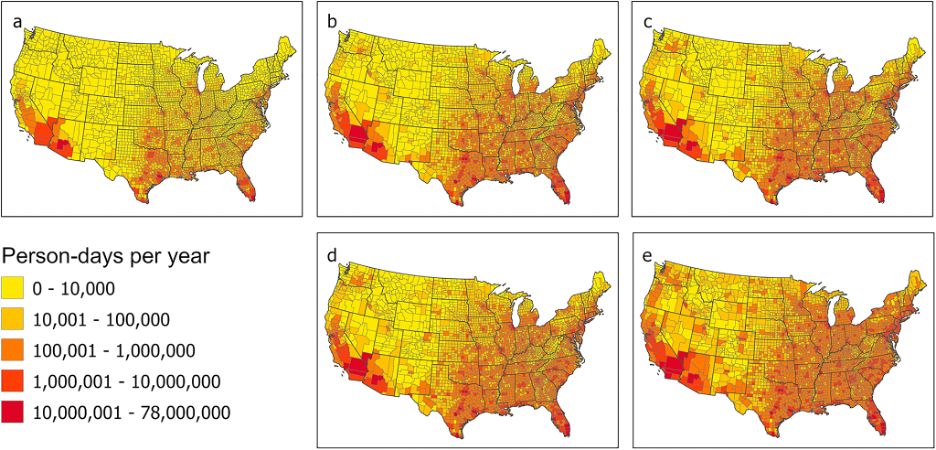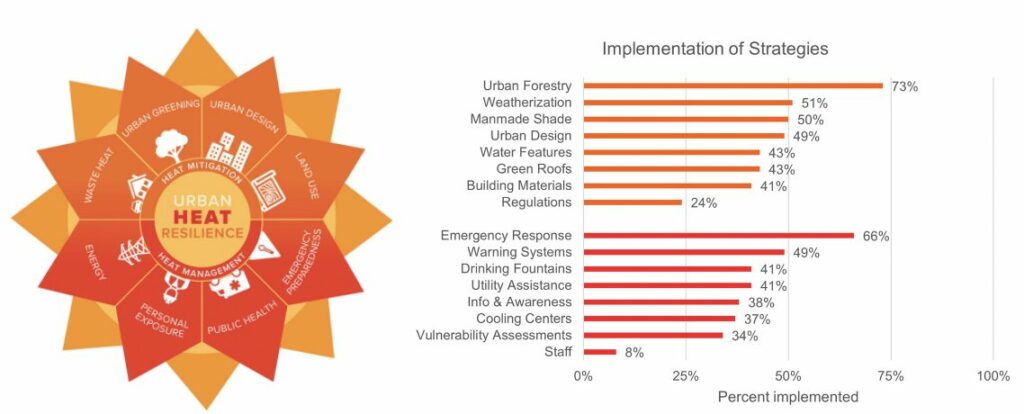Energy Innovation partners with the independent nonprofit Aspen Global Change Institute (AGCI) to provide climate and energy research updates. The research synopsis below comes from AGCI Executive Director James Arnott and AGCI Communications Manager Liz Carver. A full list of AGCI’s quarterly research updates covering recent climate change research on clean energy pathways is available online at https://www.agci.org/solutions/quarterly-research-reviews
Extreme heat is deadly serious. In the United States, heat causes more deaths than all other weather disasters combined. Extreme heat is experienced in deeply unequal ways, yet every human body ultimately confronts an upper limit of tolerance. As climate change causes more extreme heat days across the globe, heat has become a critical issue for public health and city planning.
Very recent research illuminates why extreme heat poses even greater health and economic threats than previously thought, but also points to ways we can build effective solutions to address it.
Humans may be more vulnerable to extreme heat than previously understood
Humidity significantly influences the body’s ability to tolerate heat. Hot and humid conditions make it harder to sweat, constraining our natural evaporative cooling ability. This is why weather reports often display “feels like” or heat index temperature values to represent the added impact of humidity in hot weather.
A frequently cited upper limit to human survivability is the “wet-bulb” temperature of 95º Fahrenheit (35º Celsius) (Sherwood and Huber, 2010). Taken by a thermometer covered with a wet cloth, a wet-bulb reading in effect integrates temperature and humidity conditions. Because experiencing WB 95ºF for only for a few hours—even in shade—will likely cause death even in healthy people, climate change researchers have used this threshold as an accepted value to assess the future habitability of regions.
Recently, a Pennsylvania State University physiology team wondered whether human heat tolerance might actually be lower than WB 95ºF. To figure this out, they exposed 24 healthy participating adults with a variety of body types to a range of different temperature and humidity levels.
The team found that the heat exposure level that exceeded the body’s natural cooling ability—what they call an “uncompensable” level of heat stress—occurred well below 95ºF for all subjects (see Figure 1). In humid conditions, with air temperature in the range of 96.8ºF – 104ºF (36ºC to 40ºC), the critical wet-bulb limit averaged about 86ºF (30ºC) with a range of plus or minus nearly 1.8ºF (1ºC).
In increasingly dry conditions with air temperature upward of 122ºF, the critical wet-bulb value fell below 79ºF (26ºC). In these hot-dry exposures, the researchers found that the subjects skin temperature actually increased more quickly toward critical levels relative to the hot-humid protocols. From this physiological standpoint, the authors conclude that “one universal wet-bulb temperature cannot be used to quantify human thermal tolerance across the world.”

These results suggest there is no single, universal human adaptability limit. Rather, limits will vary based on climate conditions and individual physiology. And even though the threshold of WB 95ºF has rarely been exceeded, more places already experience the lower critical values found in this study, which reinforces the immediate need to implement heat health strategies along with underlying emissions reductions that would reduce overall future warming. An interactive map created by Columbia University researchers showcases where extreme WB temperatures have been recorded, with most of those close or above WB 35ºC occurring in South Asia or the Middle East.
Without adaptation, outdoor workers will face increasing economic and health impacts
Over 30 million Americans spend most of their time working outside, performing essential functions like construction, maintenance, policing, and agriculture. Additionally, much of the work needed to achieve a clean energy transition will require substantial outdoor labor.
In a new study in the journal Elementa: Science of the Anthropocene, Rachel Licker, Kristina Dahl, and John Abatzoglou quantify the impact of future extreme heat trends on this essential workforce. Assembling future projections of heat index values, which they consider a close substitute for wet-bulb temperature, the researchers looked at future trends in climate across the U.S. and the number of working hours that would exceed the temperature thresholds at which the Centers for Disease Control and Prevention recommends reduced workload (heat index above 100ºF) or work stoppage (above 105ºF).
In the past, only the counties home to Miami, Phoenix, and Houston have experienced high levels of extreme heat exposure for outdoor workers (i.e., 10 million+ person-days/year). This analysis finds that in the future, 10 to 14 counties will experience similar levels. Ultimately, assuming no change in population, the researchers find that workers’ exposure to days with a heat index above 100ºF would increase three to four times by mid-century and four to seven times by late century, depending on emissions (Figure 2).

If no modifications to workloads or schedules occur, $39 to $55 billion in worker earnings could be at risk by mid-century. Two adaptation strategies considered in the study—modifying intensity of workload and shifting work hours to cooler times—would reverse nearly all the impact on lost earnings. But the authors acknowledge that widespread implementation of these strategies is much easier said than done, thus reinforcing the potential future risks.
Climate impacts on the outdoor workforce go beyond economic implications. Outdoor workers are often paid less, and Black and Hispanic workers experience disproportionately higher heat-related fatalities. Furthermore, many actions needed to address climate change rely on outdoor work. Water utilities, for example, are already factoring extreme heat into how they implement improvements to water systems needed to adapt to climate change.
Community engagement provides evidence for hope
As deadly serious as extreme heat can be, hopeful solutions are within reach.
Planting and maintaining trees in urban areas provides significant heat relief and can help to mitigate the inequities of extreme heat exposure, among other benefits. In Atlanta, researchers from the University of Miami and Georgia State University found summer surface temperatures can vary nearly 14ºF between vegetated and non-vegetated areas. Their analysis of planning documents showcased how efforts to preserve urban tree canopy in predominantly Black or low-income areas also dampened inequities observed in other U.S. cities. A seminal 2020 study of 108 U.S. urban areas revealed that historically redlined neighborhoods, which still retain high concentrations of low-income residents and residents of color, are nearly 5ºF warmer than non-redlined areas of the same city.
While that analysis was based on satellite temperature data, two of the study authors used a more community-based approach to collect and interpret data in one of those cities, Richmond, Virginia, which has a long history of justice and equity problems. The researchers trained community members to traverse the city with car-mounted mobile temperature sensors. The community volunteers collected more than 100,000 temperature observations, which showed that the temperature range can vary by as much as 15ºF between areas of the city at a given time. Many of the warmer areas were historically marginalized, poorer, and non-white parts of Richmond. Warmer areas also coincided with socioeconomic factors such as less tree cover, more impervious surface, poorer health outcomes, and lower life expectancy, revealing social equity and not just environmental dimensions of the heat disparity.

The data collected were instrumental in informing the City’s equity-focused climate action plan, while the data collection process itself, which took place over three-hour stints, facilitated conversation among community members about how to take action. One significant outcome was that the demonstration project led the Virginia Department of Forestry to require grantees to include similar forms of community engagement when applying for funds through their urban forestry program.
Planning to beat the heat
Taking heat seriously, and implementing strategies to beat it, will require institutionalizing the practice of heat planning in local government nationwide.
Drs. Sara Meerow and Ladd Keith, urban planning experts at Arizona State University and the University of Arizona, are at the forefront of a movement to get researchers and urban planners to work together to identify the information needs and practical strategies local governments can deploy to address extreme heat.
Their efforts have inspired an urban heat resilience framework that includes a set of local actions that cities can take to mitigate and manage heat (see Figure 4, left). Meerow and Keith also recently conducted a nationwide survey of planning professionals to understand what efforts are already underway (see Figure 4, right).

When analyzed through a regression, the two strongest predictors of whether a community plans or implements extreme heat mitigation and adaptation strategies were prior experience with heat and access to information about heat. This result suggests that under-resourced communities or those who have not yet experienced crippling heat waves may be ill-prepared for future impacts.
Conclusion
Extreme heat is perhaps the most obvious impact to expect from global warming. Yet despite its deadliness relative to other types of threats, it gets relatively little attention. Heat is harder to visualize, and unfortunately, the people who experience the worst of it are often lonely, indoors, or otherwise out of view from society. Governments typically lack departments of heat to organize countermeasures, though some like Phoenix are creating positions for Chief Heat Officers.
Research is showing that we are more susceptible to extreme heat than previously thought and that significant health and economic impacts mount with each additional degree of warming experienced this century. The good news is that a range of strategies exist to mitigate these impacts, but they will require intentional and widespread implementation to begin to remedy the structural inequities that accompany and contribute to extreme heat exposure.
Featured research:
Daniel J. Vecellio, S. Tony Wolf, Rachel M. Cottle, and W. Larry Kenney, “Evaluating the 35C Wet-Bulb Temperature Adaptability Threshold for Young, Healthy Subjects (PSU HEAT Project),” Journal of Applied Physiology 132 (2022): 340–345, https://doi.org/10.1152/japplphysiol.00738.2021.
Rachel Licker, Kristina Dahl, and John T. Abatzoglou, “Quantifying the Impact of Future Extreme Heat on the Outdoor Work Sector in the United States,” Elementa 10 (2022): 1–16, https://doi.org/10.1525/elementa.2021.00048.
Nkosi Muse, David M. Iwaniec, Chris Wyczalkowski, and Katharine J. Mach, “Heat Exposure and Resilience Planning in Atlanta, Georgia,” Environmental Research: Climate 1 (2022): 015004, https://doi.org/10.1088/2752-5295/ac78f9.
Jeffrey S. Hoffman, Vivek Shandas, and Lara Johnson, “Community Science for the (Climate) Win,” in Collaborating for Climate Equity (Routledge, 2022): 85–100, https://doi.org/10.4324/9781003208723-6.
Sara Meerow and Ladd Keith, “Planning for Extreme Heat: A National Survey of U.S. Planners,” Journal of the American Planning Association 88 (2021): 319–334, https://doi.org/10.1080/01944363.2021.1977682.